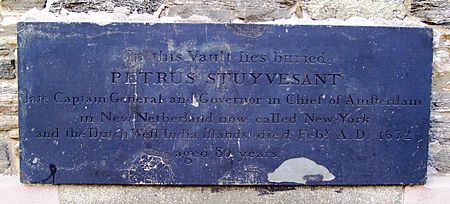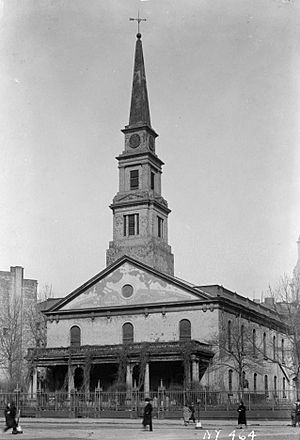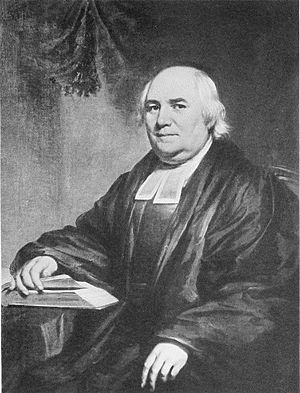St. Mark's Church in-the-Bowery facts for kids
|
St. Marks Church In-The-Bowery
|
|

Seen in 2025
|
|
| Location | 131 E. 10th St. (at Second Ave.) Manhattan, New York City |
|---|---|
| Built | 1795; 1799, restored 1975–1978, restored 1978–1984 |
| Architect | Ithiel Town, et al. Harold Edelman |
| Architectural style | Georgian; Federal body, Greek Revival steeple |
| NRHP reference No. | 72000885 |
Quick facts for kids Significant dates |
|
| Added to NRHP | June 19, 1972 |
St. Mark's Church in-the-Bowery is an old and important church in New York City's East Village neighborhood. It is part of the Episcopal Church. This special place has been used for Christian worship for a very long time, since the mid-1600s! This makes it the oldest spot in New York City where people have continuously practiced their religion. The church building itself is also the second-oldest church building in Manhattan.
Contents
History of St. Mark's Church
In 1651, Petrus Stuyvesant, who was the leader of New Netherland (an old Dutch colony), bought land for his farm. By 1660, he built a family chapel on the very spot where St. Mark's Church stands today. Stuyvesant passed away in 1672 and was buried in a special vault under this chapel.
Years later, in 1793, Stuyvesant's great-grandson, Petrus "Peter" Stuyvesant, sold the chapel land to the Episcopal Church for just $1. He asked that a new church be built there to serve the growing community. In 1795, the first stone of the current St. Mark's Church was laid. The church, built in the Georgian style by architect John McComb Jr., was finished and opened on May 9, 1799. Alexander Hamilton even helped the church become its own independent parish, separate from Trinity Church.
Changes and Growth Over Time
In 1828, a tall steeple was added to the church. Its design is thought to be by Martin Euclid Thompson and Ithiel Town, in the Greek Revival style. More changes happened in 1835 when a stone Parish Hall was built. The next year, in 1836, the church itself was updated. Its original square pillars were replaced with thinner ones in the Egyptian Revival style. A beautiful cast- and wrought iron fence was also added in 1838.
Around the same time, a two-story Sunday School building was completed. The church also started the Parish Infant School for children from poor families. Later, in 1861, architect James Renwick Jr. designed a brick addition to the Parish Hall. The St. Mark's Hospital Association was also started by church members. Outside the church, a cast iron porch, called a portico, was added around 1858. Its design is believed to be by James Bogardus, who was a pioneer in using cast iron for buildings.
At the start of the 1900s, famous architect Ernest Flagg designed the rectory, which is the home for the church's priest. The 19th century was a time of much building and growth for St. Mark's Church. The 20th century became known for its focus on helping the community and expanding its cultural activities.
Fire and Restoration
In 1966, the Poetry Project and The Film Project (which later became the Millennium Film Workshop) were started at the church. In 1975, the Danspace Project was founded by Larry Fagin. A program called the Preservation Youth Project also began, training young people to help restore the church's historic exterior.
On July 27, 1978, a fire nearly destroyed the church. A group called Citizens to Save St Mark's was formed to raise money for rebuilding. The Preservation Youth Project helped with the reconstruction, working under architect Harold Edelman. The restoration was finished in 1986. New stained-glass windows were designed by Edelman, bringing new beauty to the church.
Community and Arts at St. Mark's
The church has always been a place that welcomes different ideas and cultures. For example, Rector William Guthrie was known for including ceremonies and speakers from various traditions like Native American, Hindu, Buddhist, and Bahá'í in his services.
Today, the rectory building is home to several groups that work to preserve historic places and help the community. These include the Neighborhood Preservation Center, the Greenwich Village Society for Historic Preservation, and the Historic Districts Council. The Poetry Project, Millennium Film Workshop, and Danspace Project also continue their work there.
Over the years, many important visitors from the Netherlands have come to the church. In 1952, Queen Juliana of the Netherlands visited and placed a wreath at the bust of Petrus Stuyvesant. This bust had been given to the church by her mother, Queen Wilhelmina, and the Dutch government in 1915. Later, in 1981 and 1982, Princess Margriet and Queen Beatrix, also from the Netherlands, visited St. Mark's.
St. Mark's and the Arts
St. Mark's has supported a lively artistic community since the 1800s. In 1919, the famous poet Kahlil Gibran joined the church's Arts Committee. The next year, two large sculptures called "Aspiration" and "Inspiration" by Solon Borglum were placed at the church entrance. Gibran also gave readings of his famous writings and showed his drawings there.
Many famous dancers performed at the church, including Isadora Duncan in 1922 and Martha Graham in 1930. In 1926, poet William Carlos Williams gave a talk at the St. Mark's Sunday Symposium. Over the years, this symposium featured many well-known artists like Amy Lowell, Edward Steichen, Houdini, Edna St. Vincent Millay, Ruth St. Denis, and Carl Sandburg.
Starting in 1955, artists from the Lower East Side held an annual art show at St. Mark's during the summer. This show included hundreds of artists from the neighborhood and used both the inside of the church and its yard.
Theatre Genesis was founded at the church in 1964. In the same year, playwright Sam Shepard had his first two plays, Cowboys and Rock Garden, performed there. In 1969, St. Mark's combined church services with experimental rock music in something called the Electric Liturgy. This was the first time such a performance was shown on national television.
Today, St. Mark's continues to host modern artistic events through the Poetry Project and Danspace Project. A poetry reading in November 1971 by Patti Smith, with Lenny Kaye on guitar, even helped launch their rock and roll careers and led to the creation of the Patti Smith Group.
Notable Burials

The church has stone burial vaults under its East and West Yards. Many important New Yorkers were buried there. While the church no longer does full body burials, it still performs cremation burials in the church vault under the West Yard.
Some of the notable people buried here include:
- Charles Anthon – a scholar of ancient languages.
- John C. Colt – brother of Samuel Colt, who invented the Colt Revolver.
- Augustus van Horne Ellis – a lawyer and soldier who fought in the American Civil War.
- Thomas Addis Emmet – a lawyer and politician who served as New York State Attorney General.
- Nicholas Fish – a soldier from the American Revolution and father of Governor Hamilton Fish.
- Philip Hone – a merchant and former Mayor of New York.
- Gideon Lee – a former Mayor of New York and U.S. Representative.
- Commodore Matthew C. Perry – famous for his role in opening Japan to the West. His body was later moved to Rhode Island.
- Alexander Turney Stewart – a very wealthy New York merchant.
- Peter Stuyvesant – the Director-General of the Dutch colony of New Amsterdam.
- Daniel D. Tompkins – a Vice President of the United States and former Governor of New York.
See also
 In Spanish: Iglesia de San Marcos (Manhattan) para niños
In Spanish: Iglesia de San Marcos (Manhattan) para niños





